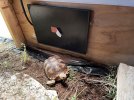Chuck_Roberts
New Member
Thanks for the feedback! I ordered the Inkbird ITC-308 WiFi Thermostat and will get to making the insulated door. I still have a lot to learn. I always thought it was normal for them to hibernate through the winter. I noticed that they aren't eating as much now either. With the shelter heat set to 80-85, will they continue to eat as normal, or eat less through the Arizona "Winter"?


